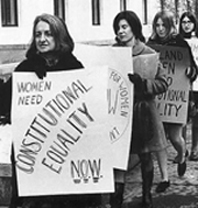THE WOMEN'S MOVEMENT
Background
“Women are an oppressed class. Our oppression is total, affecting every facet of our lives. We are exploited as sex objects, breeders, domestic servants, and cheap labor. We are considered inferior beings, whose only purpose is to enhance men’s lives. Our humanity is denied. Our prescribed behavior is enforced by the threat of physical violence.”
- Redstockings (Bitch) Manifesto (1969)
The 1960s were a time of change, when social and political issues took center stage. The movement that forever changed the balance of power in the USA was Women’s Liberation.
During the 1950s and 1960s, increasing numbers of married women entered the labor force, but the average working woman earned only 63 percent of what a man made. There was discrimination in hiring, as men were usually taken first. The women were passed over for promotions, and when they did have a man’s job, they were paid only a part of what men were paid for the same work.
 Women protested for such things as equal rights, equal salaries, maternity leave, childcare, etc. Those who started this movement were quickly labeled “feminists” and the media tried to stereotype them as radical lesbians. Women protested for such things as equal rights, equal salaries, maternity leave, childcare, etc. Those who started this movement were quickly labeled “feminists” and the media tried to stereotype them as radical lesbians.
Like the civil rights movement, the women's movement used various means in order to put an end to discrimination. Pressure groups were created, confrontation tactics like sit-ins and marches adopted, and the activists were trying to attract media attention. By the end of the 1960s, the feminists had created a vigorous campaign that demanded both legal equity and the reformation of gender roles in social institutions. The Women’s Liberation movement embraced many causes from equal rights to abortion, from legalizing contraceptives to freedom from sexual harassment.
|

